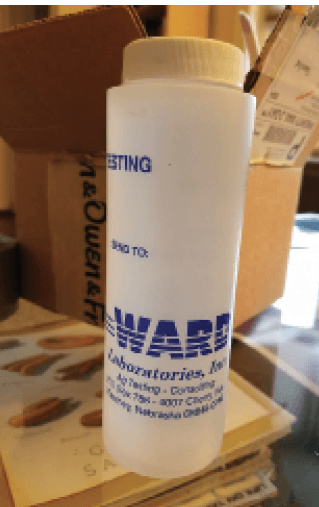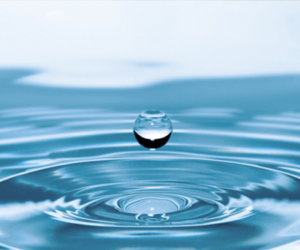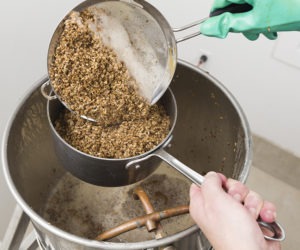Understanding Residual Alkalinity & pH

For extract brewers, water issues are largely limited to some beer flavor and water filtering concerns. The character of the malt extract has already been determined by the water used in the manufacturing process and extensive water treatment is not needed if the water used to dilute the malt extract tastes good.
For the all-grain brewer, water chemistry is more important. It impacts the enzymes that convert the starches in the malt to sugars, and therefore is critical to mashing and producing fermentable wort. The contribution of the water in mashing (with certain exceptions that will be discussed) is not so much directly related to flavor as it is in determining the proper environment for the enzymes.
Don’t have a cow, man!
It’s impossible to discuss the role of water in mashing without dealing with the underlying chemistry. This is not particularly difficult, but it does require some attention, especially by those who avoided or slept through chemistry class.
Students of the “relax, don’t worry” school of brewing may ask why they should be concerned about water chemistry when beer has been brewed for thousands of years and some homebrewers produce award-winning beers with hardly a thought about the brewing water. This attitude is not without merit. In many cases, starch conversion tends to take care of itself without any intervention. However, the nature of your brewing water supply may limit the styles that you can brew successfully without water treatment.
Most of the relevant chemistry involves the pH of the mash. Basically, pH is a measure of acidity or basicity of a solution. It is defined as the negative logarithm of the hydronium ion [H3O+] concentration. (In the past, pH was defined in terms of hydrogen ions [H+], but the nomenclature has changed to reflect the fact that hydrogen ions are almost always complexed with a water molecule.) The pH scale ranges from 1 to 14, with 7 considered neutral. A lower pH indicates greater acidity. Pure water with no dissolved minerals or gases has a pH of 7.0. Malt contains acids that lower the pH of a mash made with pure water. The pH of a mash comprised of 100 percent pale malt in pure water is 5.7–5.8, as determined by actual measurement. (If darker grains are added to the mash, the pH is lower.) If minerals are dissolved in the water, the pH of the mash will likely be altered. If you know the concentration of key ions (from dissolved minerals), you can estimate the pH shift they will cause away from the pH of a mash made with pure water.
This lowering of the mash pH by the malt acids is fortunate indeed, because the alpha and beta amylase enzymes in the malt require an acidic environment in order to do their work. To achieve adequate conversion of the malt starches to sugars, the mash pH should be between 5.2 and 5.6. Just as the malt tends to lower the mash pH, in the vast majority of cases the brewing water tends to raise it. Tap water typically has a pH ranging from 7.0 to more than 8.0, depending on the amount and type of dissolved minerals. In addition to raising the pH, the minerals dissolved in the water have another function. They also serve to buffer the pH of the mash — that is, they resist the ability of the malt acids to change it. The buffering power of minerals in brewing water is, however, weaker than the buffering power of amino acids derived from malt.
The acidification and buffering is accomplished primarily by calcium, bicarbonate and carbonate ions. Magnesium duplicates the role of calcium but to a lesser extent. When the malt and strike water are mixed, phosphates in the malt react with calcium in the water to produce calcium phosphate, which is largely insoluble and comes out of solution as a solid, releasing hydronium ions that acidify the mash and lower the pH.
Bicarbonates and carbonates in the water buffer this process, along with the amino acids in the malt. Therefore, adjusting the mash pH is a function of controlling the calcium, bicarbonate and carbonate ions in the water.
You may know that some brewers add gypsum (calcium sulfate) or calcium chloride to the mash in order to lower the pH, and calcium carbonate or baking soda (sodium bicarbonate) in order to raise it. Gypsum and calcium chloride “harden” the water (increase the calcium) and react with the malt to produce more calcium phosphate that lowers the pH. Calcium carbonate and baking soda increase the level of bicarbonates (if the pH is above 8), which has the opposite effect. It should be noted that gypsum or calcium carbonate will not raise or lower the pH of water; they alter the pH of wort due to reactions with malt components.
Get it in writing
It’s all but impossible to determine the impact of your water on the mash without a water analysis report. Most municipal water systems are required to provide this information to their customers, although you may have to ask for it politely. If you have your own water supply, you will have to send a sample to a laboratory for analysis. Ward Laboratories (www.wardlab.com) will perform Household Mineral Test W-6, which includes all the significant data for brewing. Keep in mind that the mineral composition of the water can change over time and with the seasons. Many municipal water systems frequently blend water from multiple sources and periodically alter the blending.
Five important pieces of information from the water analysis are the levels of calcium and magnesium (usually expressed as milligrams per liter (mg/L) or parts per million (ppm); these measures can be treated as equivalent to each other), the total hardness (often expressed “as CaCO3“), the bicarbonates (expressed as “HCO3“), and the alkalinity (usually expressed “as CaCO3“). Hardness is a function of the calcium and magnesium content, and alkalinity depends upon the levels of bicarbonates and carbonates. Not every water report contains all of these values. Fortunately it’s possible to derive several of them from the others.
It can be helpful to discuss the values in terms of “milliequivalents per liter” (mEq/L). An equivalent is a mole (a chemical reference unit for measuring the amount of any substance) of an ion with a positive or negative charge of 1, based on the atomic weight of its constituent elements. For example, the equivalent for calcium ions, which have a charge of +2 and an atomic weight of 40, is 20. Here are the equivalents for the relevant ions in brewing water:
Calcium (Ca2+): 20
Magnesium (Mg2+): 12.1
Sodium (Na+): 22.9
Sulfate (SO42-): 48
Chloride (Cl–): 35.4
Bicarbonate (HCO3–): 61
To convert the values expressed as mg/L or ppm in a water analysis to mEq/L, divide the concentration of the ion (in mg/L or ppm) by the appropriate equivalent values listed above. For example, if the value for calcium is 40 mg/L, divide by 20 to calculate the mEq/L as 2.0. To convert hardness and alkalinity values expressed “as CaCo3” to mEq/L, multiply by 50 (the molecular weight of calcium carbonate). Using mEq/L simplifies the math for many of the water calculations.
Total hardness is the sum of magnesium and calcium hardness. Dividing the calcium level in mg/L by 20 and multiplying by 50, or multiplying the value in mEq/L by 50, will determine the calcium hardness as CaCO3. For magnesium hardness as CaCO3, divide the magnesium level in mg/L by 12.1 and multiply by 50, or multiply the value in mEq by 50. If hardness is not separated into the contributions of calcium and magnesium, you can estimate it by attributing 80 percent to calcium and 20 percent to magnesium (the actual percentages in your water may be different). To calculate alkalinity as CaCO3, divide the bicarbonate level in mg/L by 61 and multiply by 50, or again multiply the value in mEq/L by 50.
Hardness also can be thought of as so-called “permanent” and “temporary” hardness. The latter can be removed by boiling the water or by the addition of slaked lime (calcium hydroxide), causing insoluble calcium carbonate to precipitate out of solution; the remaining hardness is deemed permanent. Put another way, permanent hardness equals total hardness minus the alkalinity.
It’s the alkalinity, stupid
It’s often convenient to discuss brewing water in terms of its hardness. In general, it can be said that soft water (with fewer dissolved minerals) is better for brewing lighter colored beers, while hard water favors darker styles. However, this is not quite accurate from a scientific point of view. The important value is really the water alkalinity, which — as mentioned in the discussion above — is related to the level of bicarbonates or carbonates.
A far more useful value is known as the residual alkalinity. This is the alkalinity not neutralized by temporary calcium and magnesium hardness, and is the real factor in determining the buffering of the mash pH by the brewing water. In the early 1950s, German brewing scientist P. Kolbach discovered that 3.5 units of calcium will react with the malt phosphates to release 1 equivalent of hydrogen ions and neutralize 1 equivalent of water alkalinity. The same is true of 7 units of magnesium. The value can be less than zero for water very low in alkalinity.
Kolbach’s formula for residual alkalinity is:
milliequivalents of RA = milliequivalents of bicarbonate – milliequivalents of calcium/3.5 – milliequivalents of magnesium/7.
How does the residual alkalinity affect the mash? Kolbach developed another formula, this time for predicting the shift in the mash pH due to the water residual alkalinity, compared to a mash in pure water. Converted to the units we have been using, his formula is:
pH shift = 0.00168 * RA (as CaCO3) or pH shift = 0.084 * RA (as mEq/L)
For all but water with the lowest RA, the pH shift due to residual alkalinity is a positive value (that is, the pH will rise). It will be negative (that is, the pH will drop) if the RA is negative. This is countered by the acids in the malt, which lower the mash pH. You may recall that in order for the malt enzymes to function correctly the mash pH should be in the range of 5.2–5.6. A mash with a high pH risks poor conversion and increases the time required. It will decrease the mash efficiency and also could result in tannins and other harsh flavors being extracted. A mash with a low pH converts poorly as well, with the additional possibilities of sourness and inhibition of the yeast metabolism.
The fact that darker malts tend to lower the mash pH is well known, but there is almost no data available as to the specific acidity of each type of malt and its contribution in reducing the overall mash pH. However, it is possible to make some generalizations about water and beer color, and in fact a formula exists for estimating the “ideal SRM” (where SRM is the Standard Reference Model for measuring beer color) of the beer brewed with a particular water, based on the residual alkalinity value. (Due to the assumptions built into this model, think of the ideal SRM as a suggestion, not a hard and fast rule.)
That formula for ideal SRM is = 0.14 * RA (as CaCO3) + 5.2. If the RA is expressed in mEq, the formula is: ideal SRM = 7 * RA (in mEq/L) + 5.2).
Water in the real world
The “ideal SRM” of the water has much to do with the beer styles historically associated with certain cities. For example, in Pilsen (residual alkalinity as CaCO3 of 1.9) this value is 5 SRM, right in the middle of the typical color range for Pilsner beers. For Dublin water (RA as CaCO3 of 66.2), the ideal SRM is 14, not as dark as the stout for which it is known, but certainly far too dark for light colored beers. A Pilsner brewed with untreated Dublin water would exhibit a long conversion time, poor mash efficiency, possible starch haze and astringency. A stout brewed in Pilsen without pH adjustment would be sour and possibly poorly attenuated by the yeast.
Those who are familiar with beer styles and brewing water may ask about the pale ales associated with Burton on Trent, which is known for extremely alkaline (total alkalinity as CaCO3 of 246 mg/L) water. The saving grace of Burton water is its correspondingly high calcium level (295 mg/L) from the naturally occurring gypsum dissolved in the water. This greatly buffers the alkalinity and results in a low residual alkalinity value (as CaCO3) of 9.0 and an “ideal SRM” of 6, which is to style for pale ales. Brewers in cities with water of high residual alkalinity eventually learned to mimic what occurred in Burton water. By adding gypsum or (less often) calcium chloride to the mash, they increased the calcium level and reduced the residual alkalinity of the water. Or they removed most of the temporary hardness, reducing the alkalinity and carbonates, by boiling the water, which causes insoluble calcium carbonate to settle out. Another option for removing temporary hardness was to treat the water with slaked lime, which produces a similar reaction. Modern brewers variously employ all of these techniques, as well as sometimes removing almost all of the dissolved minerals from a portion of the brewing water by means of reverse osmosis filtration.
Make a new plan, Stan
As an all-grain homebrewer, what should you do about your brewing water? The first thing is to obtain a water analysis and study it. Calculate the residual alkalinity of your water and the ideal SRM of the beer brewed with it. This will provide an idea what adjustments you might need to make.
Understand that it’s more difficult to brew light colored beers with water high in residual alkalinity than darker beers with low RA water. If the RA of your water is high and you are brewing a lighter colored beer, especially a style such as Czech pilsner that requires nearly neutral water, consider using a significant portion (but not all) of water filtered by reverse osmosis, or distilled water. For delicate beers this is preferable to adding too many salts that could have an effect on flavor.
Water chemistry is a complex topic and many authorities consider water adjustment as one of the last topics to be addressed as a brewers knowledge and skill increases. Don’t be surprised if your mash pH is fine without any adjustments. (But neither should you despair if adjustment is needed.) If you follow the guidelines above and your mash pH is in the proper range, you can take a drink of cool water and move on to consider other important issues that impact your beer.



